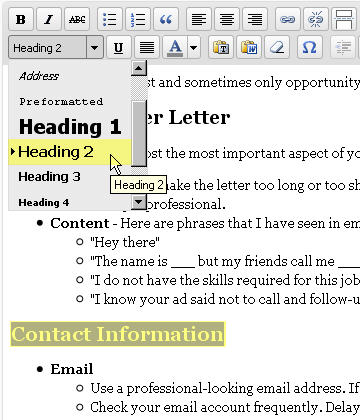Headings are a way to break up paragraphs within your blog post. If you have a blog post with several paragraphs and no headers, it can seem very intimidating to a reader. Headers provide an overview to readers and makes longer blog posts less intimidating. If you have a very long blog post, consider breaking it up into several posts. Even with headers, some readers are unlikely to read a lot of content at once.
How to Format Headings
- Type headings on individual lines by itself.
- Highlight the heading text (hold down the left click at the beginning of the header and drag your mouse to the end of the header, then release your left click).

- Click on the drop down list in the toolbar and select the header2.
Note, if you do not see a second row in your toolbar, click on the kitchen sink icon located near the end of the first row in the toolbar.

- Repeat these steps for other headings in the body of your blog post.
How to Use Heading Levels
The numbers next tot he headings do not represent the order that they appear in your blog post. They represent a hierarchy. For example, if I am writing a blog post about fruits and vegetables, fruits and vegetables are both heading2. Apples and oranges fall under fruits, so those are heading3.This is the logical and hierarchical way to use headings.
Fruits (heading 2)
Apples (heading3)
Oranges (heading3)
Vegetables (heading 2)
Broocoli (heading3)
Carrots (heading3)
According to general writing guidelines, you should not use any heading levels unless you have more than one. This is similar to bullet points,..you would not create a bullet list to display one bullet point.
Now that you understand how to use heading levels and how to format headings in a WordPress blog post, you can make your blog posts much more interesting and engaging to readers.


